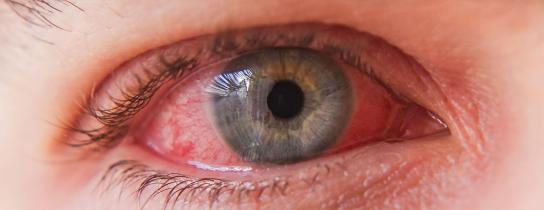
What To Do About Pink Eye
Pink eye, also known as conjunctivitis, is a common eye infection that can affect people of all ages, including about 6 million Americans each year.1 Pink eye is an inflammation of the conjunctiva, which is the thin, clear tissue that lines the inside of the eyelid and covers the white part of the eye.
While pink eye can be uncomfortable and even painful, it is usually not a serious condition and can be treated with proper care. However, it is important to seek medical attention if symptoms persist or worsen, as untreated or improperly treated pink eye can lead to more serious complications.
What Causes Pink Eye?
There are three main types of pink eye caused by a variety of factors, which includes viral pink eye, bacterial pink eye, and allergen-induced pink eye.2
Viral Pink Eye
This highly contagious form of pink eye is caused by a viral infection. It is spread through contact with infected respiratory secretions, such as tears or saliva, or from touching objects or surfaces contaminated with the virus. Viral pink eye can also accompany other viral infections, such as a cold or flu.
Bacterial Pink Eye
Pink eye caused by bacteria is also contagious and can be spread to others. It can be spread through contact with infected eye secretions, such as from touching or sharing towels, pillows, or makeup with an infected person. Bacterial pink eye can also occur when bacteria from your own skin or respiratory system infects your eyes.
Allergic Pink Eye
If you are wondering if you have pink eye vs. allergies, it may in fact be a type of eye allergy called allergic conjunctivitis (allergic pink eye). This type of pink eye is caused by allergens such as pollen, dust mites, or pet dander. It is not contagious like viral and bacterial pink eye, and occurs when the immune system overreacts to the allergen, causing inflammation of the conjunctiva.
What Are the Symptoms of Pink Eye?

Pink eye symptoms can vary depending on the cause and be in one eye or both. The most common symptoms include3:
- Redness: The conjunctiva becomes inflamed and appears red or pink.
- Itching: The eyes may feel itchy or irritated.
- Discharge: Pink eye can cause a watery or thick discharge to develop in the affected eye. The discharge may cause the eyelids to stick together, especially in the morning.
- Sensitivity to light: Pink eye can make the eyes more sensitive to light, causing discomfort and difficulty seeing in bright environments.
In addition to these symptoms, depending on the type of pink eye, you may also experience:
- Sore throat or runny nose (with viral pink eye)
- Gritty feeling in the eyes or crusting of the eyelids (with bacterial pink eye)
- Sneezing, nasal congestion, and itchy nose or throat (with allergic pink eye)
When Should You Seek Medical Attention?
You should seek medical attention for pink eye if you experience any of the following4:
- Severe pain or discomfort in the eye
- Changes in vision, such as blurred vision or sensitivity to light
- Eye redness that worsens or spreads to other areas of the eye
- A foreign object or chemical in the eye
- Symptoms that persist or worsen despite treatment
- A weakened immune system due to a medical condition or medication use
- Signs of a more serious infection, such as fever, chills, or headache
Additionally, if you have a newborn or young child with symptoms of pink eye, it is important to seek medical attention promptly. Children with pink eye may need a different treatment approach than adults, and untreated pink eye in infants can lead to more serious complications.
If you are unsure about your symptoms, your symptoms are not improving with treatment, or you are experiencing recurring pink eye, it is important to seek medical attention either from your primary care provider or through an urgent care. Your healthcare provider can help determine the cause of your pink eye and provide appropriate treatment to help relieve your symptoms and prevent further complications.
How Is Pink Eye Treated?
The treatment for pink eye depends on the cause of the infection. Some common treatment options are dependent on the type of pink eye you have5:
Viral Pink Eye Treatment
Most cases of viral pink eye will clear up on their own within a week or two without treatment. However, your healthcare provider may recommend artificial tears, warm compresses, or antihistamine eye drops to help relieve symptoms.
Bacterial Pink Eye Treatment
Antibiotic eye drops or ointments are commonly used to treat bacterial pink eye. These medications help to kill the bacteria causing the infection and reduce symptoms.
Allergic Pink Eye Treatment
Avoiding allergens is the best way to prevent allergic pink eye. Your healthcare provider may also recommend antihistamine eye drops, oral antihistamines, or other medications to help reduce inflammation and relieve symptoms.
At-Home Care for Pink Eye Symptoms

It is important to follow your healthcare provider's instructions for using eye drops or ointments and to finish the entire course of antibiotics if prescribed. In addition to medication, there are several steps you can take at home to help manage pink eye symptoms, such as:
- Applying a warm compress to the affected eye for 5 to 10 minutes several times a day
- Using artificial tears to help relieve dryness and irritation
- Avoiding contact lenses until your symptoms have resolved
- Practicing good hygiene, such as washing your hands frequently and avoiding touching your eyes
Again, if your symptoms do not improve within a few days of treatment or if they worsen, contact your healthcare provider for further evaluation.
Crystal Run Urgent Care for Fast Pink Eye Treatment
Crystal Run Urgent Care in New York is your convenient and reliable option for prompt medical attention and relief from pink eye. With experienced healthcare providers, short wait times compared to that of an emergency room, and after-hours care, patients can receive personalized and attentive service to help alleviate pink eye symptoms and prevent further complications.
Sources
- https://www.ncbi.nlm.nih.gov/pmc/articles/PMC4049531/
- https://www.aao.org/eye-health/diseases/pink-eye-conjunctivitis
- https://www.cdc.gov/conjunctivitis/about/symptoms.html
- https://www.nei.nih.gov/learn-about-eye-health/eye-conditions-and-diseases/pink-eye
- https://www.nei.nih.gov/learn-about-eye-health/eye-conditions-and-diseases/pink-eye/treatment-pink-eye

 Optum Radiology at Crystal Run Healthcare
Optum Radiology at Crystal Run Healthcare Request medical records online
Request medical records online